New York is one of only two states in this country that prosecutes and incarcerates 16 and 17 year old youth as adults, including being jailed on New York City’s Rikers Island. Today, there are about 5,000 young people between the ages of 16-21 who are held on Rikers Island. With New York City’s history of police profiling of youth of color, they are almost all youth of color who come from poor and lower middle income families and may suffer from depression and other mental health conditions. They are disadvantaged before they enter and become more so as they await trial.
One ray of light in this system is the Friends of Island Academy. Island Academy is an alternative high school at Rikers Island. Friends of Island Academy uses a model of youth advocacy to create a safe place where the youth can find a community of peers and advocates who will support them and believe deeply in their potential as they rebuild their lives after jail.
Today on HealthCetera, producer and moderator Diana Mason talks with three people who know well the need for the work of Friends: Christine Pahigian, the Executive Director of Friends of Island Academy; Marc Washington, its Mentoring Program Coordinator who shares his own experience of being incarcerated on Rikers Island; and Zaron, a young man who was released from Rikers Island in July of 2014.
The stories of these two young men speak to the need to focus on support and advocacy for youth to prevent incarceration and certainly during and after they are incarcerated.
So tune in on Thursday, April 7, 2016, at 1:00 PM to WBAI, 99.5FM in New York City and streaming at www.wbai.org. Or you can listen to the interview anytime by clicking here:
HealthCetera is sponsored by the Center for Health, Media & Policy at Hunter College, City University of New York.










Linda Tarr-Whelan / April 7, 2016
Diana — really glad to see your focus on this. No longer a New Yorker but all should be cognizant of need to give these young men a better chance on life. Come see us in VT where we are spending a lot of time, energy and money on patient-centered health care with nurses in the lead. Linda
/